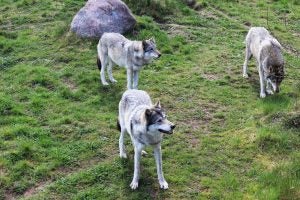In the Western United States, wolves and other predators such as grizzly bears continue to be a management concern for livestock producers. Producers have continued to introduce strategies to deter wolves from livestock-wolf conflicts, but the effects on livestock from wolves create undeniable costs including mortality and other indirect impacts.
Currently, gray wolf packs are known to be in Washington, Oregon, California, Idaho, Montana, Wyoming, Michigan, Wisconsin, Minnesota, and Alaska. Additional wolves have dispersed into other states with a reintroduced population of Mexican gray wolves in Arizona and New Mexico.
Over the years, wolf populations have reached a point in some states where the legal harvest is now allowed. In 2020, the U.S. Fish and Wildlife Service delisted gray wolves in the Northern Rocky Mountain Population. Although a federal judge relisted the gray wolf in 2022, wolves in Idaho, Montana, and Wyoming as well as some areas in Washington, Oregon, and Utah are no longer protected by the Endangered Species Act.

Idaho, in particular, has held an estimated population of 1,500 or more gray wolves. Earlier this year, Idaho expanded lethal wolf removal and hunting by up to 90 percent of the state’s population allowing the trapping and snaring of wolves.
The U.S. Fish and Wildlife Service suggests a management range of about 500 wolves in Idaho, which would likely reduce wolf and livestock conflicts while maintaining a stable wolf population.
Despite recent changes to the expansion of methods and seasons for hunting wolves, the wolf population in this state seems to be holding steady. Last year, the state made $200,000 available for payments to hunters and trappers who kill wolves in the state expanding killing methods to include trapping and snaring wolves on a single hunting tag, without restriction to hunting ours, night-vision equipment with a permit, or bait and dogs and motor vehicles.
Montana lawmakers also changed their laws to expand wolf hunting and removal. This month, the trapping quota was expanded to 456 wolves across districts one through seven.

Last month, wolf depredations continued across the Northwestern United States.
- In California, CDFW confirmed one wolf depredation on livestock.
- Montana has the added challenge of fighting grizzly bears on the range. In October, the Livestock Loss Board reported 12 head of cattle, 21 ewes, and 21 lambs lost to grizzly bears. Wolves killed two head of cattle, two lambs, and 37 rams.
- Oregon wolves were responsible for the loss of five head of cattle and depredations on five goats in October.
- After non-lethal measures failed to stop depredations, ODFW authorized lethal removal of wolves from the Balloon Tree Pack in Union County. Following last month’s authorization of a Horseshoe Pack lethal removal, a wolf from the pack was trapped and lethally removed on private land in Umatilla County where previous depredations had occurred. The wolf was an uncollared, non-breeding adult male. A second Horseshoe Pack wolf was lethally removed on Saturday, Oct. 29 on private land in Umatilla County.
- Washington reported two confirmed wolf depredations on livestock in October. Following continued wolf-livestock conflicts in the Smackout pack territory, the department removed a yearling female at the end of the month. WDFD extended the authorization to remove one more wolf from the pack.
Unfortunately, with wolf-human conflicts, illegal taking or killing of wolves require investigation and include fines or possible jail time for those charged.
- WDFW is investigating six wolf mortalities with the Wedge pack territory in Stevens County, an ongoing investigation that began in February after toxicology results revealed six wolves died from ingesting poison. A reward of $51,400 is offered for information about the poisoned wolves.
- On October 18, OSP Fish and Wildlife issued a call looking for the public’s assistance in locating the person(s) responsible for shooting and killing a wolf in the Lookout Mountain Unit in Baker County.
- In Colorado, officials believe that three wolves shot and killed in Wyoming may have belonged to the North Park wolf pack. Although Colorado boasts a large fine of up to $100,000 for killing a wolf, Wyoming’s predator zone allows for legal hunting of wolves.


